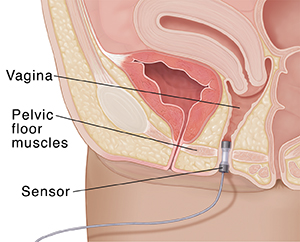Urinary Incontinence
Treating Incontinence in Women with Medicine
Treating Incontinence in Women with Medicine
Urinary incontinence is the leaking of urine from the bladder. In some cases, medicine can reduce or stop the leaking. It's mainly given for urge incontinence, a sudden need to urinate that is hard to delay. Your healthcare provider will talk with you about your choices. Make sure to ask what side effects to expect.

Below are some types of medicines that may help with urge incontinence.
Types of medicine
-
Anticholinergics or beta-3 adrenergics. These may increase how much urine the bladder can hold. They may also help relax bladder muscles. The most common side effects of anticholinergic medicines are dry mouth and constipation. Sucking on sugar-free candy or chewing gum and supplementing your diet with fiber may prevent these side effects.
-
Estrogen. This may help improve muscle tone in the urethra and bladder.
-
Antibiotics. These are used to treat urinary tract infections.
-
Botulinum toxin. Injection of botulinum toxin into the bladder muscle is an option when other medicines are not effective. Botulinum toxin injection can be effective in treating urine leakage for up to 6 months. If successful, this treatment may be repeated.
Tips for taking medicine
-
Take your medicine on time and as your healthcare provider tells you to.
-
Tell your healthcare provider if you have any side effects. Your dosage may be adjusted if needed.
-
Be patient. It may take time to find the right dose for you.
-
Keep a list of the medicines you take. Show it to your healthcare provider and pharmacist before you buy over-the-counter medicines.
Special Therapies
Treating Incontinence in Women: Special Therapies
Your healthcare provider will discuss your choices for treating your urinary incontinence. These depend on the cause of your problem and any other health issues you have. Often behavioral changes are tried first, followed by various medicines. If these methods are unsuccessful, 1 or more of the therapies described below may be part of your treatment plan.
Biofeedback
This method is taught by a nurse or physical therapist. During the therapy, a small sensor is placed in your vagina or rectum. Another sensor is placed on your stomach. Other types of sensors are also available. These sensors read signals from the pelvic floor muscles. When you contract or relax your muscles, these signals are shown as images on a computer screen. Using the images, you can learn to relax or contract certain muscles. This can help you strengthen and better control these muscles. And it can help you learn pelvic floor muscle exercises.

Electrical stimulation
This is a painless therapy that uses a tiny amount of electric current. It helps strengthen very weak or damaged pelvic floor muscles. The electric current is sent through the muscles of the pelvic floor and bladder. This causes the muscles to contract. In time, this helps make the muscles stronger.
Stimulator implants
This method is used to treat urge incontinence. A small device is implanted under the skin near the upper buttocks. This device gives off mild electrical signals. These block extra signals that are being sent to the bladder muscle. This helps the bladder work more normally.